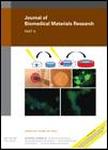版权所有:内蒙古大学图书馆 技术提供:维普资讯• 智图
内蒙古自治区呼和浩特市赛罕区大学西街235号 邮编: 010021

作者机构:Univ Toronto Dept Chem Engn & Appl Chem Toronto ON M5S 3E5 Canada Univ Toronto Dept Chem Toronto ON M5S 3E5 Canada
出 版 物:《JOURNAL OF BIOMEDICAL MATERIALS RESEARCH》 (生物医学材料研究杂志,B部分:应用生物材料)
年 卷 期:1998年第42卷第1期
页 面:13-19页
核心收录:
学科分类:0831[工学-生物医学工程(可授工学、理学、医学学位)] 08[工学] 0805[工学-材料科学与工程(可授工学、理学学位)] 0836[工学-生物工程]
主 题:cell-substrate interaction cell adhesion cell repulsion guidance poly(ethylene glycol) hippocampal neurons patterning peptides
摘 要:Glass surfaces were patterned with cell-adhesive regions of laminin adhesive peptides YIGSR, RGD, and IKVAV, and cell-repulsive regions of poly(ethylene glycol) (PEG). The patterns were created by sputter-coating titanium and then gold onto glass coverslips through electron microscope grids. Gold surfaces were modified with cysteine-terminated peptides to have approximately 450 fmol/cm(2) of peptide incorporated on the glass coverslips as determined with radiolabeled CGYIGSR. Amine-functionalized glass coverslips were prepared using an amine-functionalized silane and then further modified with PEG-aldehyde by a Schiff base reduction. All surfaces were characterized by X-ray photoelectron spectroscopy and water contact angles. Hippocampal neurons, plated from a serum-free medium, adhered preferentially to peptide-functionalized surfaces over PEG-modified surfaces. Cell adhesion and neurite outgrowth were limited to the peptide region, demonstrating that neurite outgrowth could be directed by a combination of cell-adhesive and cell-repulsive cues. (C) 1998 John Wiley & Sons, Inc.